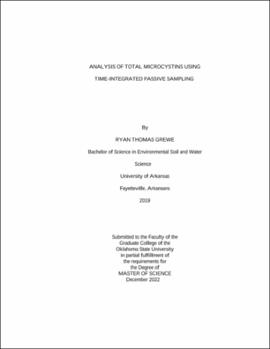| dc.contributor.advisor | Belden, Jason | |
| dc.contributor.author | Grewe, Ryan Thomas | |
| dc.date.accessioned | 2023-08-02T19:47:06Z | |
| dc.date.available | 2023-08-02T19:47:06Z | |
| dc.date.issued | 2022-12 | |
| dc.identifier.uri | https://hdl.handle.net/11244/338778 | |
| dc.description.abstract | Microcystins are the most common freshwater cyanotoxin and present a risk to wildlife and humans who may interact with contaminated water bodies. Detecting microcystins in the environment presents a challenge as microcystins can have heavily fluctuating concentrations, and a sensitive analysis is required to detect concentrations below toxic levels. Passive sampling offers a way to integrate potentially fluctuating or low microcystin concentrations with time, which may allow for a more toxicologically relevant analysis of microcystins in the environment. However, current analytical methods associated with passive sampling of microcystins are not well suited for detecting all microcystin variants (of which there are over 200). Therefore, the purpose of this study was to explore the feasibility of coupling passive sampling with the analysis of total microcystins (all variants). To do so, microcystins were harvested directly from cyanobacteria cultures and used to calibrate passive samplers. Both Gas Chromatography—Mass Spectroscopy (GC-MS) analysis and Enzyme-Linked Immunosorbent Assay (ELISA) were assessed as methods for analysis of total microcystins from passive samplers. While both methods had exceptional detection limits for total microcystins, ELISA was chosen as the simpler and more efficient analysis. Three passive sampler designs were tested using polyethersulfone, nylon, or steel membranes to enclose the sampler sorbent to determine the effects of pore size and membrane material on sampling rate of total microcystins. The uptake of dissolved and cell-bound microcystins were then further investigated in the polyethersulfone and nylon samplers. All 3 sampler designs were successfully calibrated for analysis of total microcystins, with nylon and polyethersulfone samplers having exceptional linear uptakes of microcystins over time. Furthermore, it was determined that coupling ELISA analysis with passive sampling using steel or nylon samplers could theoretically reach much lower detection limits than with grab sampling. The high uptake rate of steel and nylon samplers may make them better suited for short-term studies, while the lower uptake of polysulfonate samplers may be better for longer studies. Although it remains unclear how well cell-bound microcystins may bind to the samplers, lower detection limits and the continuous collection of data from these samplers may prove ideal for monitoring of microcystins in the environment. | |
| dc.format | application/pdf | |
| dc.language | en_US | |
| dc.rights | Copyright is held by the author who has granted the Oklahoma State University Library the non-exclusive right to share this material in its institutional repository. Contact Digital Library Services at lib-dls@okstate.edu or 405-744-9161 for the permission policy on the use, reproduction or distribution of this material. | |
| dc.title | Analysis of total microcystins using time-integrated passive sampling | |
| dc.contributor.committeeMember | Dzialowski, Andrew | |
| dc.contributor.committeeMember | Jeyasingh, Puni | |
| osu.filename | Grewe_okstate_0664M_17887.pdf | |
| osu.accesstype | Open Access | |
| dc.type.genre | Thesis | |
| dc.type.material | Text | |
| dc.subject.keywords | cyanobacteria | |
| dc.subject.keywords | microcystins | |
| dc.subject.keywords | passive sampling | |
| thesis.degree.discipline | Integrative Biology | |
| thesis.degree.grantor | Oklahoma State University | |
